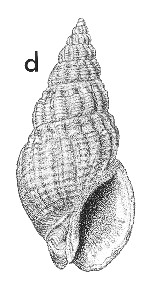
Revised descriptions of New Zealand Cenozoic Mollusca from Beu and Maxwell (1990)

 | Revised descriptions of New Zealand Cenozoic Mollusca from Beu and Maxwell (1990) | 
|
  (Pl. 42d): GS10337, 032/f8843, Oaro submarine canyon faunule, summit of hill east of Glenstrae homestead, northern Hundalee Hills, southern Marlborough, Nukumaruan (GNS) |
Beu & Maxwell (1990): Chapter 15; p. 322; pl. 42 d.
Synonymy: Buccinum nassoides Reeve 1846, pl. 3, fig. 12; Cominella (Eucominia) otakuaica Powell 1946b, p. 143, pl. 12, fig. 5-7; Cominella (Eucominia) nassoides otakauica, Beu & Maxwell 1990, p. 322, pl. 42d.
Type species of Eucominia Finlay, 1926
Classification: Buccinulidae
Description: Large for genus (45-65 mm high), tall and narrow, with tall, straight-sided spire, but short last whorl with short, strongly twisted, widely open canal, producing short, wide fasciole margined by narrow ridge. Sculpture of a prominent, wide spiral cord below suture and many low, narrow, closely spaced spiral cords from shoulder angle to base, leaving narrow, weakly sculptured area around strongly concave sutural ramp; crossing moderately prominent, closely spaced axial costae of rounded section, narrow and high on spire whorls but becoming less prominent on later whorls, and obsolete on last whorl of large shells; forming low, rounded nodules on subsutural cord and shoulder angle. Aperture wide, oval, with thick lips, lirate inside outer lip of small specimens but smooth in large ones. Protoconch large, dome-shaped, of 2 smooth whorls.
Comparison: The cold-water, southern members of Cominella (Eucominia) are characterised by their prominent sculpture of spiral cords and axial costae, with a strongly concave sutural ramp and a nodulous shoulder. More temperate species (C. mirabilis; and in particular, C. elegantula, Castlecliffian; Pl. 49e) have much smoother shells but most still have a subsutural cord and concave shoulder. The form named C. nassoides otakauica by Powell (1946b) differs from the shallow-water Stewart Island "subspecies" C. nassoides (Reeve) only in its larger size and more weakly sculptured last whorl, and is merely a deep-water ecomorph of no taxonomic significance, intergrading completely with shallow-water specimens of C. nassoides. Most of the other named forms also intergrade with C. nassoides. This cold-water species lives only in southern New Zealand today, the larger otakauica form occurring only on the continental shelf and slope off eastern Otago and in Pegasus Bay, Canterbury. Its extension northwards to North Canterbury, Marlborough and (rarely) southern Wairarapa during Nukumaruan time is further evidence of the glaciations indicated by the northward range expansions of Zygochlamys delicatula to the central North Island.
Distribution: Mangapanian?; early Nukumaruan-Recent. Recent, trawled off eastern Otago (type of the otakauica form); common in shelf and submarine canyon mudstone facies in Marlborough and Cheviot area, Canterbury (Mangapanian?; common in Nukumaruan) and in shallow-water Castlecliffian of the Leader River, near Cheviot; rare in southern Wairarapa.
Cite this publication as: "A.G. Beu and J.I. Raine (2009). Revised
descriptions of New Zealand Cenozoic Mollusca from Beu and Maxwell (1990). GNS
Science miscellaneous series no. 27."
© GNS Science, 2009
ISBN
978-0-478-19705-1
ISSN 1177-2441
(Included with a PDF facsimile file
copy of New Zealand Geological Survey Paleontological Bulletin 58 in CD version
from: Publications Officer, GNS Science, P.O. Box 30368 Lower Hutt, New
Zealand)